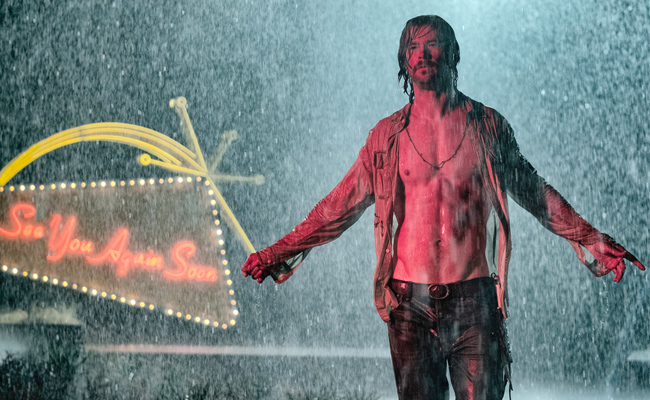
(Ed. Note: This review originally ran a couple of weeks ago when it was screened at Fantastic Fest in Austin. We’re republishing it today, Friday, October 12, because it opens nationwide today.)
In his second film as a director, Drew Goddard from Cabin In The Woods has managed to harness the energy of one of those slowed-down dramatic covers used to set the mood in countless movie trailers, creating essentially the platonic ideal of the dramatic cover, set to cinema. It’s a tour de force of tastefulness.
You know the mood I’m talking about: a half-speed, dramatic version of a song you know, or kind of know, used to create this sense of eerie deja vu, familiarity mixed with foreboding and a dash of foreshadowing (at least, at its best, I’m not talking about the countless failed attempts at same, such as the pirate children singing “Smells Like Teen Spirit” in Pan).
There was “Mad World” in Donnie Darko, and “Creep” in The Social Network, but if anything, Bad Times At The El Royale harkens back to an even earlier example, Striking Distance, from 1993, which used “Little Red Riding Hood” as the serial killer’s musical cue. That idea, of an old foot-tapper echoing through tinny speakers (see also “Hurdy Gurdy Man” in Zodiac), pervades Bad Times At The El Royale, a neo-noir set at an old hotel on the outskirts of Reno to the tune of sixties doo-wop. It’s very much a mood movie, and mood movies, to some extent, either work on you or they don’t. For me, it was almost more impressive as a virtuoso performance by Goddard than as a work of storytelling.
The plot, laid out with Hitchcockian simplicity, concerns the four new arrivals to a big empty hotel straddling the California-Nevada state line: Laramie Seymour Sullivan, a loud-mouthed vacuum cleaner salesman played with Foghorn Leghorn-like aplomb by Jon Hamm; Darlene Sweet, a lounge performer played by Cynthia Erivo, who spends so much of the film singing (beautifully); Father Daniel Flynn, played by Jeff Bridges, who at 68 still has an incredible head of hair; and a surly hippie chick played by Dakota Johnson who signs the guest book simply, “Fuck You” (later we learn that her name is Emily).
They all seem to have an angle and none of them are exactly who they seem. Then there’s the matter of the mysteriously empty hotel (“you should’ve seen this place in ’66, it could really swing,” Hamm’s character tells us in the opening scene) and its odd, frequently absent caretaker, Miles, a flinchy Rockwell painting come to life that I realized about 20 minutes in was Bill Pullman’s son (Lewis Pullman).
Goddard, who still shoots action scenes like they’re jump scares, uses a non-linear timeline with scenes bookended by title cards of the corresponding room — room one, room four, maintenance closet, etc. — such that the film kind of feels like a mix of Four Rooms, The Shining, and Grand Budapest Hotel.
Like the El Royale Hotel itself, El Royale the movie is set just after that mid ’60s high water mark of Americana, when some of the best music and culture that the country would ever produce were already a few years behind it (“you should’ve been here in ’66…”). A vague sense of decline has set in — reflected in the El Royale‘s increasingly dusty furniture and general disrepair, and the headlines about a “Malibu massacre” (a fairly clear reference to the Manson family) flashing by on TVs throughout the film.
There’s also a subplot about a sex tape, starring someone like JFK or RFK from the way they describe it, that gives a sense that maybe all that opulent Americana wasn’t all that it was cracked up to be, even then. El Royale is Richard Nixon, it’s Hunter Thompson’s wave, it’s the Manson Family, it’s the end of 1960s optimism, it’s the rise of paranoid cultism, most clearly reflected in the persona of Billy Lee, a handsome Jim Jones type played by Chris Hemsworth, whose American accent has thankfully gotten a lot better since 12 Strong. The El Royale (the hotel) is a decaying museum of sixties optimism, and it, like the characters, isn’t quite what it seems.
That Goddard is so conversant with pop cinema tropes is both his greatest strength and his weakness. You couldn’t do much better than El Royale in terms of composition or scene setting, and of course it helps that it’s set in such a lush time period and its choice of music — black doo-wop and early rock from the early to mid-sixties, from the Isley Brothers, Sam Cooke, et. al. — is perfect, the kind of music that always gives me goosebumps, from the power and purity of the vocals alone.
For as good as the setting and premise are though, Bad Times is a movie movie, to a fault at times. The characters always feel a bit more like cute, clever characters than actual people. And at two hours and 20 minutes, by the time the last couple of title cards flash up on the screen, there is a slight feeling of “Oh Christ, there’s more?”
Bad Times is unhurried, to a fault. But when it’s good, it’s good.
‘Bad Times at the El Royale’ opens October 12. Vince Mancini is on Twitter. More reviews here.






